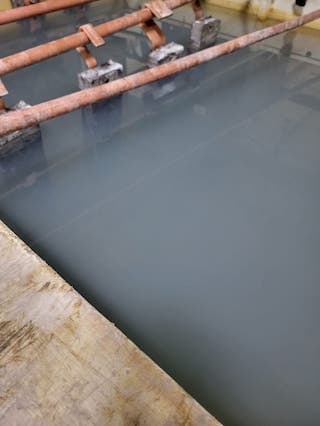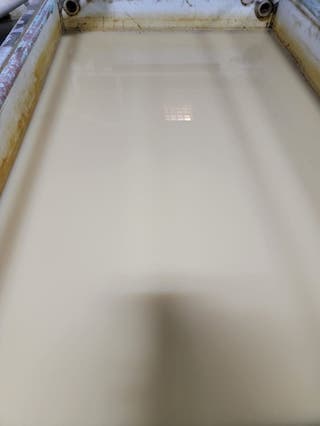
-----
Color of tin plating bath; problem with acid tin brightener
this text gets replaced with bannerText

-- this entry appended to this thread by editor in lieu of spawning a duplicative thread
Q. Good morning fellow platers. Recently I have encountered a problem this problem with my Tin solution, it is turning grey when it usually has a yellowish tint to it, I have reached the conclusion that Tin is not dissolving in it, so my question is, am I right? If I am, how can I help the Tin that is not dissolving properly dissolve in the solution? Or is there any other explanation to it? Greetings and thanks for the help!


- Chihuahua, Mexico
October 28, 2022
⇩ Related postings, oldest first ⇩
Q. I have an acid tin brightener bath. After three months the color of bath turns yellow. What is the reason, and how can we treat it.
Hoba Ahmed- Egypt
2003
A. Enthone, for one company, sells a material to treat their tin solution. But our cost analysis showed it was cheaper to generate a new tank solution than treat the old one; less down time and pain also.
James Watts- Navarre, Florida
A. Hoba-
Just because the bath changed color does not mean you have a problem. Acid tin baths do discolor as you use them. Is the tin deposit still giving you good results? What is being told to you is a clarification chemical? A bath three months old should not require this treatment. Do you filter the bath constantly? You should have a chiller to maintain temperature no more than 65-70 °F.
You should also be using sulfuric acid at 10% as your acid after the cleaning step. Chlorides can kill acid tin. If you are using muriatic acid, that's not good.
- Grand Rapids, Michigan
A. I disagree in part with Mr. Hemp. The color change your bath is experiencing is normal due to the oxidation of the tin in the solution from stannous to stannic. Generally, if you wish to use color as a guide to when a bath should be discarded, or cut or "clarified" (floc'd) the color to look for is a dark "coffee with cream". At this point you will find that you are having difficulty maintaining brightness despite additions of additives. This would be different from chloride contamination which regardless of color will result in a dull or etched finish despite treatments or addition agents.
As to temperature, some brightener systems enable operation at temperatures up to 95 °F. Ideally, the trade off between conductivity, chilling cost and brightener cost is about 80 to 85 °F with modern brightener systems.
process supplier - Great Neck, New York
A. Dear Sir,
The problem of your bath becoming yellow is in fact an oxidation to metastanic salts - It should not be a problem to plate from an electrolyte in that stage providing you are depositing from Sn+2. The presence of such by-product in large amounts causes premature yellow deposits and sometimes problems with solderability.
You may reduce the presence of the metastanic salts in your bath by filtering from time to time with "granular" activated carbon "not powder", the same type you use in water softening equipment or deionizers. It depends on what kind of brightener system you are using, the bath will be able to work at around 40 °C !
The use of Clarifiers or polyelectrolytes designed specifically for that purpose by vendors of processes is also an alternative; however, you should bear in mind that the amount of sludge produced by this treatment is tremendous and carries along a major portion of the good brightener as well as some Sn+2 from your bath.
SurTec do Brasil Ltda - S B Campo SP, Brazil
Q. I work as a process eng. in a plant where we have an electrolytic acid copper and tin line for PCB based components. My question is addressed to know if the situation we are having in our tin bath is normal or not, even though we are not facing real problems with quality of plating. This is a stannous sulfate-acid bath and with the use we have found white-yellowish fine-solid residues formation on the tank. Although analysis show what expected from our supplier in means of Sn and acid Concentration and we do the corresponding additions to keep it, the appearance has changed from the original amber color of the make up. If we agitate the solution becomes"chocolate shake"-like, and after settling it turns back to its actual gray-brown color. Originally we had Sn nuggets on Ti baskets as our anodes, but we found out the hard way that Ti should not be used here (baskets were literally consumed). Now, I'm about to place tin bars to replace this anodes but before this I would like to know if the solid formation is normal (if so what this could be) and if not if I need to remove it before putting the new anodes or not. Then what are main characteristics to look into the bath, besides analysis and Hull Cell ⇦ huh? that could help us to ensure that it is in normal conditions. Your comments will be appreciated. Regards,
David A [surname deleted for privacy by Editor]electronics - San José,Costa Rica
2003
A. Hi, David. Sorry, I can't quite answer your question. However, other people have reported colors with their tin baths which may either give your assurance that nothing is seriously wrong or get you on track to understanding it.
So we appended your inquiry to a thread where a "dark coffee with cream" color is described as the point where the bath must be discarded or fixed, and that description sounds pretty similar to your "gray-brown ... chocolate milk shake". Good luck!
Regards,

Ted Mooney, P.E.
Striving to live Aloha
finishing.com - Pine Beach, New Jersey
Ted is available for instant help
or longer-term assistance.
-- this entry appended to this thread by editor in lieu of spawning a duplicative thread
Q. What color should an alkaline sodium stannate (tin) solution be?
I've heard it should be "straw" colored. Ours was dark grey, and now it is light grey after adding 1 quart of 30% hydrogen peroxide per 50 gallons. I want to add more to improve the deposit appearance.
Is too much hydrogen peroxide bad, or does it just turn into water and oxides?
Does acetic acid
⇦ on
eBay
or
Amazon [affil link] treatment (to reduce sodium hydroxide) have to be glacial, or is white vinegar
⇦in bulk on
eBay
or
Amazon [affil link] acceptable?
Thanks,
Plating Engineer - Tucson, Arizona, USA
2007
-- this entry appended to this thread by editor in lieu of spawning a duplicative thread
Q. I must say I am very new to Electrolytic Tin plating. I have been using a commercial solution of Tin(II) in Sulfuric Acid for the past three months. I have noticed that the solution is now turning yellow. Any ideas what could be happening?
Thanks for your help.
Plating Engineer - Danbury , Connecticut, USA
October 7, 2008
Sorry! Site is temporarily read-only as we deal with
intense Chinese hacking crashing e-mail servers.
